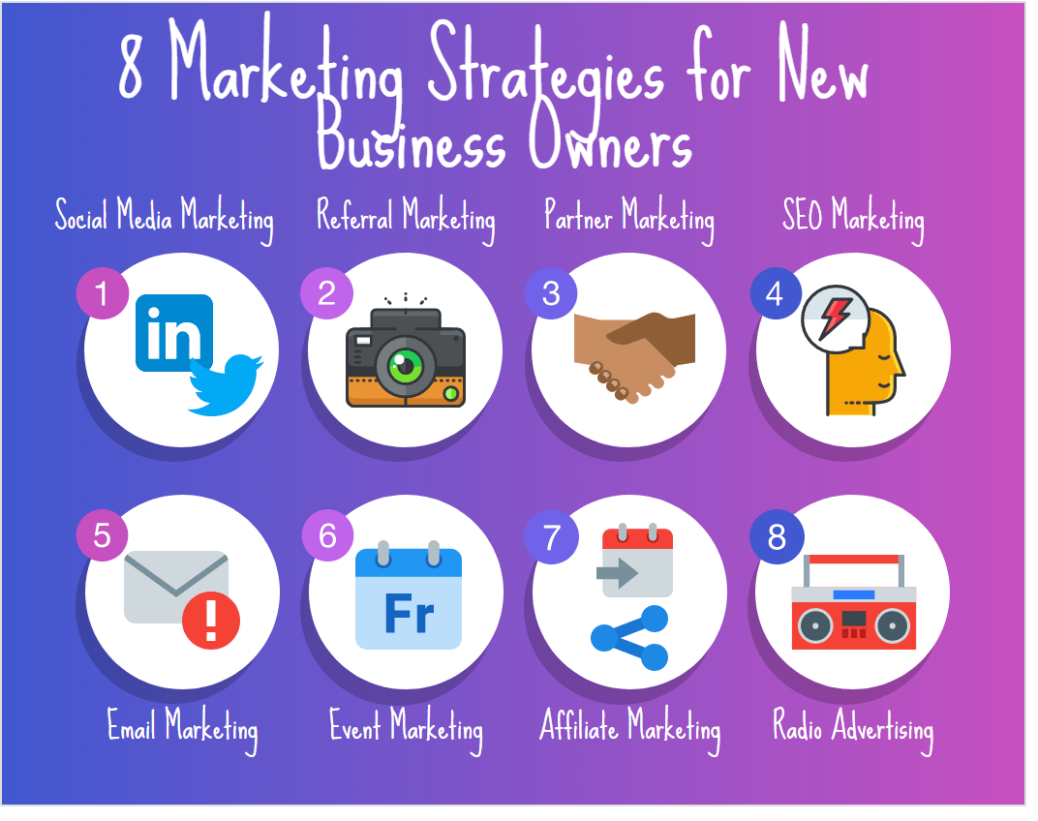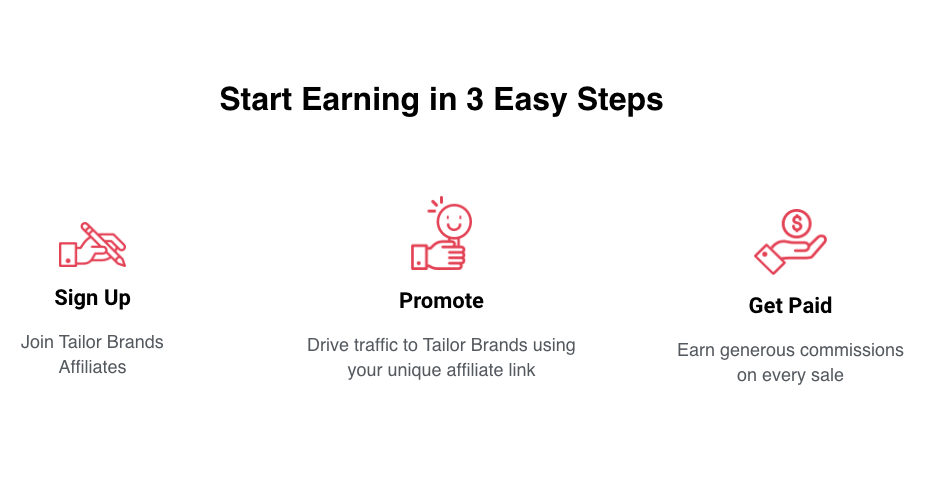Best Marketing Strategies for New Business Owners
Starting a new business is exciting, but it also comes with a lot of unique challenges. One of the most significant hurdles you’ll have to overcome is marketing your new business. Fortunately, with digital tools and services, promoting your business has never been easier. All it takes to build an audience is perseverance, high-quality content, and this list of the best marketing strategies. Some of these best marketing strategies include social media marketing, partner marketing, SEO marketing, affiliate marketing and event marketing.
Table of Contents
We spoke to Adam C, from Ignite SEO, a UK based SEO company, and he said, “ New business owners should take advantage of the advanced technology we have today. For example, we no longer need to go door by door selling our goods and services. There are many successful ways we can use to sell our products online and even gain a strong customer base that will have the business booming in no time. Marketing has been made easy for business owners, and one of the best ways is SEO. SEO marketing is there to help entrepreneurs create user friendly websites that will introduce their goods and services to the market. The websites rank higher on search engines like google and in return helps bring more potential customers, resulting in more sales and profits,”
Let’s get into it to see all the strategies and what they are about.
Best Marketing Strategies
1. Social Media Marketing
Since sites like Facebook and Twitter have taken over the world, they’ve become indispensable for both new and established businesses. Best of all, you can sign up and build profiles on these sites for free, which helps improve your marketing ROI. (Return on investment is a ratio between net income and investment.)
That said, it can take a while to gain some traction on social media, so you have to be patient. Here are some tips and tricks for getting the most out of your social profiles:
- Understand each platform – Facebook is excellent for sharing video content, as well as acting as a proxy for your website. So, even if you’re still waiting for an official business web page, you can use Facebook as a placeholder. Each platform has its pros and cons, and you need to understand how to leverage them for your brand. For example, Instagram is excellent as a photo gallery, while Twitter allows you to communicate your brand voice with your audience more directly.
- Understand your audience – Who are you selling to and which platform do they use the most? Older generations tend to prefer Facebook, while younger users like TikTok and Instagram. That said, knowing where to find your customers is only the first part. Then, you have to create content that will appeal to them. Creating customer avatars is an excellent way to generate customized and personalized content, regardless of the marketing strategy.
- Engage with your followers – Social media is a 2-way street, so you have to be active on your profiles. If you don’t respond to messages or comments, followers won’t engage with your brand. You should also be highly proactive on these pages, asking for feedback and commenting on other posts and links. Doing this shows your customers that you’re interested in what they have to say, so they’re more likely to pay attention.
- Use paid ads – One of the best reasons to invest in social media is that you can access tons of user data. This way, you can make sure that your ads are getting to the right people. This option can also boost your profile much faster than it would organically.
2. Referral Marketing
Did you know that up to 92% of consumers trust recommendations from people they know? This statistic should pique your interest and illustrate the value of referral marketing. As you’re growing your business, one of the easiest (and most affordable) tactics is to encourage customers to refer your brand to their friends and family. How does this process work exactly? Here are some tips:
- Remind everyone to refer your business – Whether someone purchased one item or 100, you want to ask every customer to tell other people about your business. This is because most customers will forget about referrals or won’t take the time to do it. Let’s say that your referral rate is 5%. If you ask 20 people to refer your brand, maybe 5 of them will. But, if you ask 100 customers, you could get up to 20 referrals.
- Incentivize referrals – One of the most well-known case studies in referral marketing is Dropbox. When the company was first starting, it told customers to get other people to sign up. For doing that, the current customer would get extra storage for free. Since the storage was a huge benefit, Dropbox saw a massive influx of new customers. Get creative with your incentives and offer things like discounts, free goodies, and more. Doing this will motivate current customers to be brand ambassadors.
- Create a compelling argument – People are paying more attention to brands these days and how they act. Companies are expected to uphold certain social responsibilities, and those that do get rewarded with customer loyalty. Your clients will be more willing to spread the news if you can illustrate how your business is doing well. So, when asking for referrals, try to incorporate your company’s mission statement.
Once you have your referral program mapped out the next step is to add it to your website where you can direct visitors and interested partners. The below page from Girlfriend Collective is a cool example of how to layout your referral program web page.

Image Source: Girlfriend Collective
3. Partner Marketing: One of the Best Marketing Strategies for Newcomers
Since you’re a new business, you may struggle to find an audience quickly. One way to circumvent this problem is to partner with a more well-established brand. Partner marketing is highly valuable because it offers mutually beneficial results for all parties involved. Depending on your business model, you may be able to partake in a few different types of partner marketing. There are different types of partner marketing you need to know.
- Affiliate marketing – In this case, an affiliate (e.g., a blogger) promotes your products and gets a small commission on each sale. We’ll dive into this marketing tactic later on.
- Distribution marketing – If you can partner with a complementary company, you can bundle items for added value to your customers. For example, maybe you sell dog toys and partner with a company that sells dog food. So, for every bag of food someone buys, they get a free toy and vice versa.
- Cross-promotion – In this instance, you and your partner promote each other’s businesses. So, instead of bundling products, you simply advertise for each other. As with distribution marketing, you want to find a partner that aligns with your brand’s identity without competing for the same customers. One example could be a party supply company partnering with a DJ service.
You can partner with brands for one campaign or you can forge a long-term relationship in partner marketing. The details of your partnership can depend on several factors, but you want to have specific goals in mind before agreeing to be a part of partner marketing. This way, you can track your progress and see if the partner marketing strategy is delivering any benefits.
Undoubtfully digital marketing can grow your business. Here below you can find a very helpful article on this topic.
4. SEO Marketing
When it comes to digital marketing tactics, search engine optimization (SEO) is often a company’s top priority. The reason why SEO marketing is so valuable is that everyone uses search engines to find products and businesses. So if you’re not ranking high on these search results, you’re falling behind the competition.
According to recent data, 53% of all search traffic goes to the top spot. Unfortunately, up to 90% of all pages don’t rank and get no organic traffic from Google. Because the field is so competitive, it can take a while to gain traction from SEO marketing. However, now is the best time to utilize smart SEO tactics for SEO marketing to be successful, as they’ll pay off in the long run.
Here are some tips:
- Optimize every page – When building your site, be sure to optimize your pages with meta tags, title tags, and focused keywords. Doing this will help each page rank for a specific keyword.
- Do your research – See which words users search for the most and focus on the top-ranking words. Investing in this research helps you stay focused when building page content.
- Get creative – You’re probably not going to rank highly for generic terms like “restaurant” or “toy shop,” so don’t bother. Instead, choose more specific keywords like “organic vegetarian restaurant” or “handmade toy shop.” Narrowing your focus helps you rank higher and aligns your business with unique demographics.
- Be patient – You won’t see results immediately, but don’t let that discourage you. Over time, as your audience grows, your SEO marketing strategies will pay off.
- Use paid ads – As with social media, you can leverage a marketing budget to capture a bigger audience faster. While organic SEO is valuable, it’s much harder to get. If you have the money, spend it on targeted ads.
5. Email Marketing
As with SEO marketing, email is another major player in the digital marketing field. When used correctly, emails can have a tremendous impact on your bottom line. Unfortunately, many companies don’t utilize email marketing as much as they should.
Here are some ways to make it work for your business:
- Segment your lists – The most significant problem that companies face is that they send the wrong emails to the wrong users. It will take time to segment all of your subscribers, but this effort will pay off. Use keywords and triggers to make sure that you send targeted content to each person. Doing this will get much more engagement (up to 760% more!).
- Cut your losses – If someone doesn’t open a single email for months, it’s often not worth it to keep them on a list. Focusing only on active users saves you time and money. Not only is it easier to segment your lists, but you can generate a lot more buzz and momentum, which will only continue to grow.
- Be active – If you’re only sending a couple of emails per year, your user base will ignore you. Instead, come up with a regular schedule for different types of messages. For example, perhaps you have a monthly newsletter and a weekly coupon. Having a regular schedule ensures that you can maintain momentum with active users.
6. Event Marketing
Event marketing can be a great option for some businesses. If you’re a location-based business (e.g., a restaurant or retailer), hosting an event is an excellent way to introduce yourself to the area which will be the base for event marketing. Not only are you in control of the situation, but you can build buzz around your business. Plus, if the event is successful, you can host future events to market your business further.
Here are some ways to get more out of event marketing strategy:
- Have goals in mind – Hosting an event won’t do much for your business if you don’t know what you’re trying to accomplish. Do you want to sell a specific number of items? What about getting people to sign up for your email list? Write down goals so that you can make sure that the event marketing was a success. If it wasn’t, you can adjust and try again next time.
- Set a budget – Events can quickly get expensive if you’re not careful. Try to limit the event to a certain number of people or rely on existing infrastructure as much as possible. You can also request RSVPs to get an idea of how many guests to expect.
- Offer something – Freebies are always a good idea, even if you just have some branded swag to give away. You can also incorporate a contest with a big prize to entice guests even more.
7. Affiliate Marketing
We mentioned this strategy earlier, but it can be a viable way for new businesses to build an audience quickly. That said, affiliate marketing is often reserved for online stores and brands. However, you can have an ambassador program for in-person sales as well.
When developing your affiliate marketing strategy, make sure to reach out to influential sites and people. The higher the profile, the bigger the audience will be. You will need to negotiate a commission rate and you’ll have to set benchmarks for the affiliate to hit. Not having a contract can hurt you later on, especially if the affiliate doesn’t hold up their end of the bargain.
The best part about this marketing strategy is that it can have a massive ROI. Since you only pay a commission on each sale, you don’t have to invest any money upfront.
Once you nail down the details of your affiliate offering, make sure to create affiliate page on your website that outlines the details of the program. Below you can see how Tailor Brands the logo design and branding company layout their affiliate it’s a great example of how to position your affiliate offering.
Image Source: Tailor Brands
8. Radio Advertising
Finally, we have an old-fashioned marketing tactic that can still have some impressive results. Even with streaming services widely available, tons of people still listen to the radio. Up to 83% of all U.S. adults (age 12 or higher) listen to the radio regularly, so there’s a massive audience available.
Another advantage of radio advertising is that it works well for local markets. You can also pair this strategy with others, such as hosting an event as a part of event marketing. You can promote the event on the radio, thus ensuring that more people will attend. That said, make sure that you provide details and repeat them multiple times throughout the ad. Doing this will make it easier for listeners to remember. If possible, come up with a jingle that will stick in their minds.
Best Marketing Strategies: Over to You
Effectively marketing your new business can be challenging. That being said, at least one of these 8 marketing strategies are worth considering for your business such as social media marketing, SEO marketing, partner marketing, or event marketing.
Decide which marketing strategy works best for your new business and then run tests with each strategy to see what works.
Infographic


11+ years strategic communications, marketing, and project management experience. I am a trainer at StarWood Training Institute, focusing on online courses for project management professionals.











